







Musk Lorikeet, Glossopsitta concinna, is a largish lorikeet
22cm in length. It has an overall dark green plumage with blue tinge on the
crown of the head and olive/bronze on lower back of neck. There are bright
red patches on the forehead and from under each eye to the upper/side of
the neck. Beak is overall black with a tan/brown tip. The head is a distinctive
shape with the red patched brow protruding. Wing feathers are red tipped and
tail is yellow/green.
Eyes are light brown to dull orange, feet green/olive to brown.
All of our musks are extremely active and never stop chattering and arguing.
Apart from the two breeding pairs who have their own aviaries almost all
of the rest are in one 6metre long aviary/flight.
This 'communal' musk aviary sometimes has an occasional Scaley or two sharing
the aviary, Musks and Scaleys seem to coexist with no problems.








|
May 2000
Below are images of a complete family of Musk Lorikeets that we collected
recently, these images are from just a few hours after we introduced them
to their new home. There is a breeding pair of Musks and five children
from two sets of eggs. There are two about eleven months old and three
that are five months old.
The babies all appear to have been well handled from very young, they are
very human friendly and are in excellent health. Their greatest concern
was to get at food as several of the photos show. We have introduced them
to some food items they have not had before and their enthusiasm had to be
heard to be believed. The excited noise was deafening, the food dishes were
wiped clean and a blended fruit/honey/biscuit/water mix was guzzled in
double quick time.
These new additions are going to be special characters, we can see that
each of the babies has its own personality.










|
The parents of the five musk babies shown above.



|
On 10 August 2000 our first pair of musk lorikeets were born, from the
breeding pair we obtained earlier in May.
The first images are of the pair from 1 week old. One of the pair died just
after 3 weeks and the second was removed from the nestbox at just 5 weeks
old. The parents had plucked most of its body feathers and were just starting
on its head and wing feathers. It was hand raised until fledged.
It was named Chatter because it never stopped chattering.
She developed several yellow
plumage patches and early her red cheek patches started to fade away to a
yellow colour. After first moulting these returned a bright red although the
yellow plumage on her wings and back remained.
click on image below to display full size






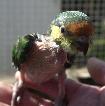
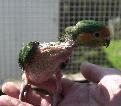

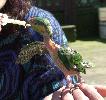








|
December 2001
During this year we have had two breeding pairs of Musks that have produced
quite a few babies.
The pair we obtained in May 2000 produced another single chick in October
(after Chatter- see above), a cock named Tiny, then on new years day two
chicks (the twins) a hen and cock, in April a single cock Noodle, in June
another pair, Zak and Zoe, and again another pair in August 2001, only one
of which survived. As of December 2001 they have again hatched two babies
that are still in the nestbox.
The second pair produced one cock bird in September 2000, Spotty, then nothing until August 2001 when two were born, a cock and hen. In November a single hen was produced. This pair seem to produce babies that are noticeably smaller in size than the first pair. They also appear to be less developed although so far all have survived. Once they reach 3 months they quickly catch up in size and strength. One interesting feature is that this pair have a very blue plumage on their heads (like a cap) whereas the first pair have almost no blue.
Below are images of most of these babies as they developed throuhgout 2001.
Spotty, born September 2000, the first chick from our second breeding pair. Spotty had almost no yellow colouring but instead inherited from his parents a very blue plumage on his head. Initiallly this was mixed with yellow/red feathers which gave a strange appearance. As he moulted this almost totally disappeared except for one tiny yellow spot which has now almost disappeared.
click on image below to display full size






|
Twins born 1 January 2001. These two also developed a substantial amount of ' yellow plumage. Hand raised from about 4 weeks old after the parents were thought to have started plucking them.
click on image below to display full size
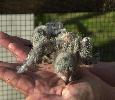



|
Zak and Zoe, born July 2001. Both developed substantial yellow plumage in the chest, neck and upper back areas. They were hand raised in the company of two same age Scaleys.
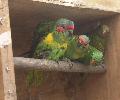



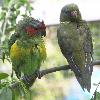


|
Runty, born October 2001. Noted almost from the day he was born to be extremely small in size we though it unlikely he would survive. However, he proved to be a fighter and always enjoyed over eating so that often his crop was so full he could not stand up - or later fly!
click on image below to display full size

|
